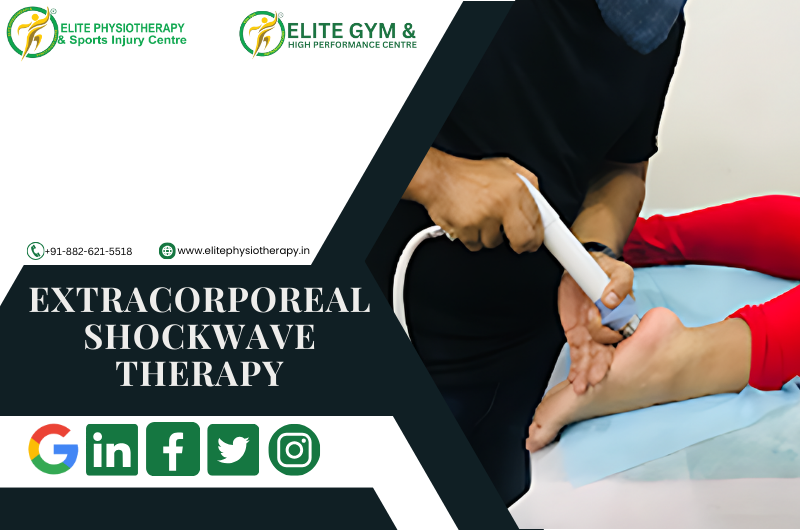Revolutionizing Rehabilitation with TR-Therapy
At Elite Physiotherapy and Sports Injury Centre, we take pride in continuing to lead the way in medical innovation by providing innovative treatments that transform recovery and rehabilitation. One of the most cutting-edge techniques we use is TR-Therapy, a novel therapy designed to speed up recovery, lessen discomfort, and increase general mobility. Modern technology and individualized treatment are flawlessly combined in this therapy, guaranteeing each patient receives the best possible outcomes.
What is TR-Therapy?
Targeted Radiofrequency Therapy, or TR-Therapy for short, is a non-invasive therapeutic approach that uses high-frequency electromagnetic energy to encourage deep tissue repair. In contrast to conventional treatments, TR-Therapy induces regulated hyperthermia (deep heating) by penetrating deeply into muscles, ligaments, and connective tissues. Significant pain reduction, enhanced circulation, and a quicker recovery are all made possible by this special mechanism. The versatility of TR-Therapy, which can be utilized with or without thermal effects, makes it ideal for a variety of injuries and medical disorders.
How TR-Therapy Works?
A closer look into TR-Therapy’s process reveals that it uses a combination of ergonomic applicators and sophisticated radiofrequency radiation to give targeted treatment:
- Capacitive Mode: This mode concentrates on soft tissues and the skin, targeting superficial tissues. It’s perfect for ailments like small sprains or inflammations that need to be treated at the surface level.
- Resistive Mode: The resistive mode targets deeper structures, such as tendons, joints, and muscles. It works especially well for joint stiffness, deep muscle injuries, and persistent pain.
- Dynamic Impedance Control: During therapy, a state-of-the-art function called Dynamic Impedance Control continuously analyzes tissue impedance. This guarantees the best possible energy delivery, modifying in real time for optimal efficacy and comfort.
Patients frequently report feeling a calming warmth that eases tension and relaxes muscles during therapy. TR-Therapy’s combination of thermal and physical impacts makes it both fun and effective.
Applications of TR-Therapy at Elite Physiotherapy and Sports Injury Centre
At our center, we include TR-Therapy into all-encompassing treatment programs to address a variety of ailments. Here are a few of the most important uses:
1. Management of Chronic Pain
The quality of life can be greatly impacted by chronic pain, particularly in regions like the shoulders, neck, or lower back. Deep tissue relaxation, a reduction in muscle tension, and long-term pain relief are all benefits of TR-Therapy. For people with ailments like frozen shoulder, cervical spondylosis, or lumbar pain, this makes it a great choice.
2. Improved Muscle Regeneration
Active people and athletes frequently have small tears, overuse injuries, and muscular weariness. TR-Therapy increases oxygen delivery to tissues and circulation, which speeds up muscle recovery. This therapy helps patients return to optimum performance more quickly, whether they are recovering from strenuous training sessions or treating sports-related injuries.
3. Edema and Post-Traumatic Swelling
Edema and swelling can impede the healing process for those recovering from surgery or trauma. The non-thermal application of TR-Therapy efficiently lowers inflammation and encourages lymphatic drainage, which speeds up healing and increases mobility.
4. Myofascial Pain Syndrome
Widespread pain and stiffness can be caused by trigger points in muscles and fascia. TR-Therapy precisely targets these regions, relieving tension and reestablishing regular muscular function. This is particularly helpful for ailments like tennis elbow, IT band dysfunction, and plantar fasciitis.
5. Tendon and Joint Rehabilitation
Rest and rehabilitation must frequently be carefully balanced in cases of joint and tendon injuries. The focused approach of TR-Therapy guarantees efficient therapy without overtaxing the afflicted area. Because of this, it is the preferred treatment for tendinitis, ligament sprains, and arthritis.
Why Choose Elite Physiotherapy and Sports Injury Centre?
Elite Physiotherapy & Sports Injury Centre was founded in 2008 and has been at the forefront of revolutionizing rehabilitation and physiotherapy in India. What sets us apart is this:
- Holistic Rehabilitation: Our method helps patients get back to their regular activities or sports after receiving therapeutic treatment. We place a strong emphasis on result-oriented healing, making sure that patients not only recover but also perform at their best.
- Cutting Edge Facilities: We provide our patients with the newest developments in medical technology thanks to our state-of-the-art physiotherapy equipment, which includes TR-Therapy systems.
- Tailored Care Plans: Each patient at Elite Physiotherapy is given a customized treatment plan based on their unique requirements, objectives, and recovery schedules. To optimize benefits, TR-Therapy is smoothly included into these plans.
- Sports Physiotherapy Expertise: We have years of expertise treating athletes and active people, and our focus is on improving athletic performance and treating sports injuries.
Experience the Difference
At Elite Physiotherapy and Sports Injury Centre, we combine knowledge, technology, and compassion to provide unmatched care. TR-Therapy is evidence of our dedication to quality and innovation in rehabilitation. TR-Therapy can be extremely beneficial whether you’re trying to improve your athletic performance, manage a chronic illness, or recover from an injury.
Stop by our office today to learn more about how you can include TR-Therapy in your healing process. Allow us to assist you in starting along the path to an active and pain-free life.





